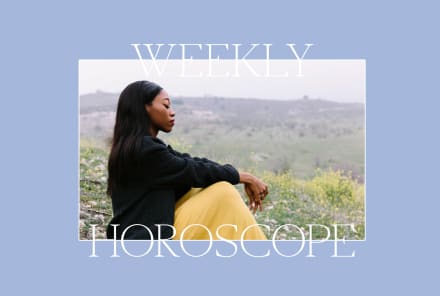Advertisement
A Medical Intuitive Predicted My Health Problems: Here's What I Learned


When the petite brunette, soccer-mom type ushered me into her suburban kitchen, I felt slightly disappointed. She seemed so "normal." What had I expected? Someone New Age-y? Perhaps someone barefoot?
Just an hour earlier, my fiancé had asked if I could take his appointment with a medical intuitive, since he was stuck at work. "A what?" I asked. "Just go," he encouraged. "It's cool. She's like a health psychic." I accepted his offer not because I had any medical concerns but because I was curious. What the heck would she have to say to me? Newly engaged after being a single mom, I was feeling happy, healthy, and invincible.
My first appointment with a medical intuitive
After we sat down at her kitchen table, the medical intuitive (let's call her Carol) picked up a small piece of paper with a drawing of the human form on it, much like the chalk outlines associated with crime victims. We sat in silence for at least five minutes.
Finally, she spoke: "It's such an honor to be in your presence. Your organs are remarkably clean." I felt proud and vindicated that all that exercise and my organic lifestyle had paid off. Then the next sentence struck: "But I have to tell you that your skeletal structure is breaking down." What? She proceeded to give me advice on how to cope when my now-inevitable skeletal collapse occurred. For me, a college professor and independent single mom, her words felt completely foreign. Nothing she said had any bearing on my current blissful, healthy reality. Yet, ever the good student, I dutifully took notes, which I shoved in my backpack at the end of our session as I skipped out the door toward my future.
Years later, her predictions came true.
I married, had a baby, adopted two more, kept working, exercised frequently, and put our encounter behind me, except for the occasional dinner party brag that a medical intuitive had been honored by my internal organs.
Then, it happened. A few years after I met with Carol, I helped carry a wheelchair-bound student down the stairs when the university's power went out and felt a searing pain in my back. I'd ruptured a disc in my lower back (L4) and was also given a diagnosis of spinal stenosis. This set in motion a series of what could only be termed skeletal events. Multiple discs in my lower back and neck herniated. Then my knees started to fail. I've had five surgeries since then, most recently a knee replacement at the age of 54. Carol's dire warning about my skeletal structure had come true!
Thanks to my perennially messy backpack, I was able to unearth the piece of paper with the advice I'd halfheartedly scribbled down during our chance meeting. As a strong, athletic woman who took pride in her independence, most of this advice had meant nothing to me when I was healthy. But when my injuries began, I started referring to them often. I'm passing them along, because you never know when you might need them!
1. Accept help from a wide array of sources and people.
I was so compromised by my injuries that I had no choice but to follow this tip. I spent a lot of time on crutches, which forced me to accept help with driving, shopping, and other daily chores. On the positive side, my five children learned to step up and help, whereas in the past, I tended to do more for them than was necessary.
2. Make adjustments to reduce pain.
Everything from sleeping to getting in and out of a car was incredibly painful. Motrin, Arnica, body pillows, Epsom salt, ice packs, and a heating pad all played a role in my attempt to reduce pain.
3. Get emotional and physical support.
Understanding that support isn't just physical took a little while for me to come to terms with. But when I did, it was key to my healing process.
4. Stress will make things worse.
I resisted the reality that my hectic, overloaded lifestyle undermined the healing process. I kept trying to power through my regular high-stress routine of packing too much into a day with no downtime, but it simply didn't work. I couldn't get better until I broke away from my stressful habits, such as working late hours, running around trying to please everyone, and always trying to maintain that competitive edge. Instead, I recalibrated and adjusted my goals to include mindful breathing, time outdoors, and a good night's sleep!
5. Try an alternative approach and find professionals who make you feel better.
When I felt hopeless and ravaged by back pain, the advice to look beyond traditional medicine and locate practitioners who were most effective was invaluable. Standard rehab didn't help as much as I'd hoped, so I tried massage, cupping, acupuncture, and a variety of alternative approaches. I learned who and what made me feel better. In the early stages, it was exhausting, expensive, and demoralizing, but through trial and error, I figured out that a combination of acupuncture and light exercise helped me recover with very little residual pain.
6. Stick with what works.
The path to well-being isn't always interesting or exciting, but I paid attention to how my body responded to certain exercises, and I stuck with the successful ones.
7. Listen to your body.
At one point, I was told to do a very limited and boring back exercise called the "arch and curl" five times a day. The first day, it felt ridiculous, but then I noticed that the pressure on my inflamed sciatic nerve was decreasing every day. I listened to my body and now stick with this very basic exercise when I feel my back flare up.
8. Commit to healing.
My commitment to healing extended beyond the pain-management stage. After trying out various exercise programs, I found that Pilates was my route to strength, flexibility, and stress relief. Integrating a regular Pilates practice into my life is a lifelong expression of my deep commitment to healing on many different levels.
9. You can't do it all.
As a single mom, I was always overcompensating and trying to be Super Woman. I worked a full-time job, dedicated myself to my children, and exercised at odd hours. My self-care looked great from the outside, but in reality, I was spread way too thin. My injuries forced me to slow down and reconsider the relentless pace I'd come to accept as normal.
The guidance I received from my chance encounter with the medical intuitive was a great comfort when I was grappling with the shocking experience of being physically compromised. Was she really psychic, or did I simply receive a list of practical truisms? In the end, it doesn't really matter. She gave me excellent advice that I had no idea I would desperately need.
Watch Next
Enjoy some of our favorite clips from classes
Enjoy some of our favorite clips from classes
What Is Meditation?
Mindfulness/Spirituality | Light Watkins
Box Breathing
Mindfulness/Spirituality | Gwen Dittmar
What Breathwork Can Address
Mindfulness/Spirituality | Gwen Dittmar
The 8 Limbs of Yoga - What is Asana?
Yoga | Caley Alyssa
Two Standing Postures to Open Up Tight Hips
Yoga | Caley Alyssa
How Plants Can Optimize Athletic Performance
Nutrition | Rich Roll
What to Eat Before a Workout
Nutrition | Rich Roll
How Ayurveda Helps Us Navigate Modern Life
Nutrition | Sahara Rose
Messages About Love & Relationships
Love & Relationships | Esther Perel
Love Languages
Love & Relationships | Esther Perel

















